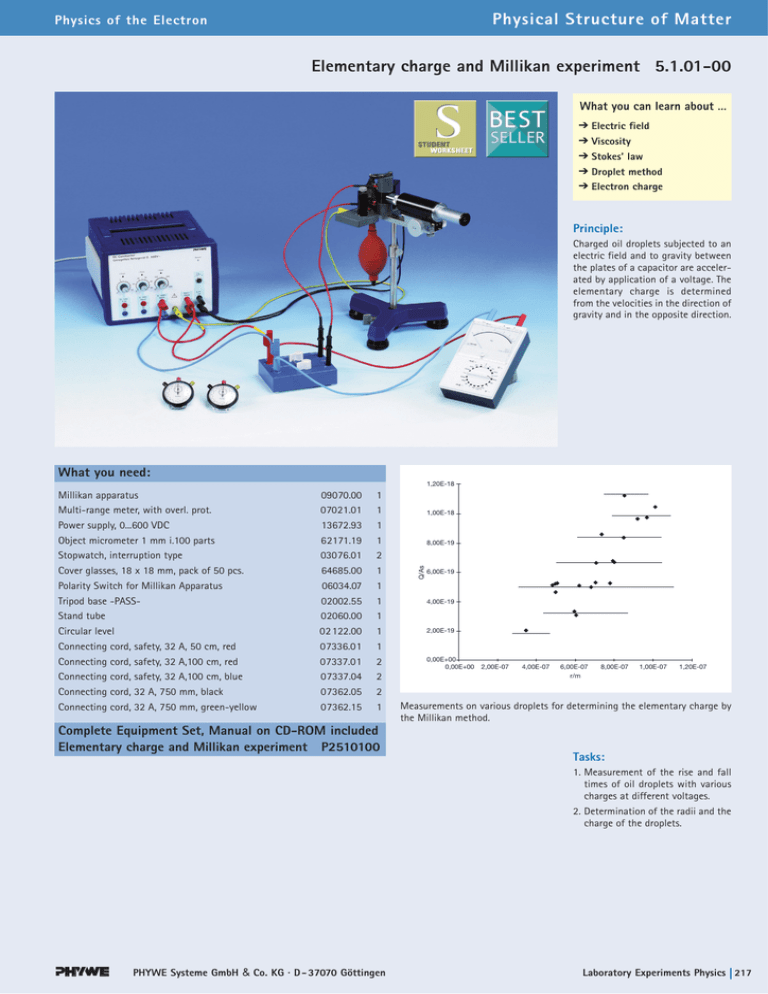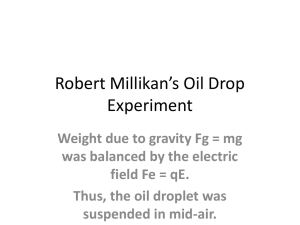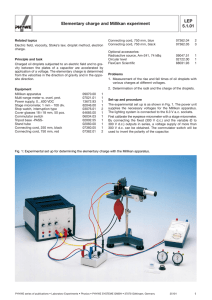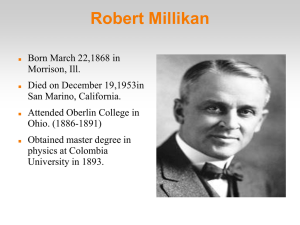Elementary charge and Millikan experiment 5.1.01
advertisement

Physical Structure of Matter Physics of the Electron Elementary charge and Millikan experiment 5.1.01-00 What you can learn about … Electric field Viscosity Stokes’ law Droplet method Electron charge Principle: Charged oil droplets subjected to an electric field and to gravity between the plates of a capacitor are accelerated by application of a voltage. The elementary charge is determined from the velocities in the direction of gravity and in the opposite direction. What you need: 1,20E-18 09070.00 1 Multi-range meter, with overl. prot. 07021.01 1 Power supply, 0...600 VDC 13672.93 1 Object micrometer 1 mm i.100 parts 62171.19 1 Stopwatch, interruption type 03076.01 2 Cover glasses, 18 x 18 mm, pack of 50 pcs. 64685.00 1 Polarity Switch for Millikan Apparatus 06034.07 1 Tripod base -PASS- 02002.55 1 Stand tube 02060.00 1 Circular level 02 122.00 1 Connecting cord, safety, 32 A, 50 cm, red 07336.01 1 Connecting cord, safety, 32 A,100 cm, red 07337.01 2 Connecting cord, safety, 32 A,100 cm, blue 07337.04 2 Connecting cord, 32 A, 750 mm, black 07362.05 2 Connecting cord, 32 A, 750 mm, green-yellow 07362.15 1 Complete Equipment Set, Manual on CD-ROM included Elementary charge and Millikan experiment P2510100 1,00E-18 8,00E-19 Q/As Millikan apparatus 6,00E-19 4,00E-19 2,00E-19 0,00E+00 0,00E+00 2,00E-07 4,00E-07 6,00E-07 r/m 8,00E-07 1,00E-07 1,20E-07 Measurements on various droplets for determining the elementary charge by the Millikan method. Tasks: 1. Measurement of the rise and fall times of oil droplets with various charges at different voltages. 2. Determination of the radii and the charge of the droplets. PHYWE Systeme GmbH & Co. KG · D - 37070 Göttingen Laboratory Experiments Physics 217 LEP 5.1.01 -00 Elementary charge and Millikan experiment Related topics Electric field, viscosity, Stokes’ law, droplet method, electron charge. Principle Charged oil droplets subjected to an electric field and to gravity between the plates of a capacitor are accelerated by application of a voltage. The elementary charge is determined from the velocities in the direction of gravity and in the opposite direction. Equipment Millikan apparatus Multi-range meter w. overl. prot. Power supply, 0…600 VDC Stage micrometer, 1 mm - 100 div. Stop watch, interruption type Cover glasses 1818 mm, 50 pcs. Commutator switch Tripod base -PASSStand tube Connecting cord, l = 250 mm, black Connecting cord, l = 750 mm, red Connecting cord, l = 750 mm, blue Connecting cord, l = 750 mm, black 07362.04 07362.05 2 3 Optional accessories: Radioactive source, Am-241, 74 kBq Circular level FlexCam Scientific Pro II TV set 09047.51 02122.00 88030.93 1 1 1 Tasks 1. Measurement of the rise and fall times of oil droplets with various charges at different voltages. 2. Determination of the radii and the charge of the droplets. 09070.00 07021.01 13672.93 62171.19 03076.01 64685.00 06034.03 02002.55 02060.00 07360.05 07362.01 1 1 1 1 2 1 1 1 1 1 2 Set-up and procedure The experimental set up is as shown in Fig. 1. The power unit supplies the necessary voltages for the Millikan apparatus. The lighting system is connected to the 6.3 V a. c. sockets. First calibrate the eyepiece micrometer with a stage micrometer. By connecting the fixed (300 V d.c.) and the variable (0 to 300 V d.c.) outputs in series, a voltage supply of more than 300 V d.c. can be obtained. The commutator switch will be used to invert the polarity of the capacitor. Fig. 1: Experimental set up for determining the elementary charge with the Millikan apparatus. PHYWE series of publications • Laboratory Experiments • Physics • © PHYWE SYSTEME GMBH & Co. KG • D-37070 Göttingen P2510100 1 LEP 5.1.01 -00 Elementary charge and Millikan experiment – Set the capacitor voltage to a value between 300 V and 500 V. – Blow in the oil droplets. – Select an oil droplet and by operating the commutator switch move the droplet between the highest and lowest graduations on the eyepiece micrometer. Correct the focusing of the microscope if necessary. Note the following criteria when selecting the droplet: – The droplet must not move too fast, then it has a small charge (it should need ca. 1…3 s for the way of 30 div.) – The droplet must not move too slowly and should not exhibit any sqaying movements. Increase the capacitor voltage if required. – Sum together some rise times using the first stopwatch. – Sum together some fall times using the second stopwatch. – The added times should be greater than 5 s in both cases. Theory and evaluation The falling and rising movement of a charged oil droplet in the electric field of the capacitor is obverserved and the velocities are determined. Velocity falling in the electric field Velocity rising in the electric field Capacitor voltage Charge on the droplets Radius of the droplets Capacitor interelectrode distance Density of the silicone oil Viscosity of air Gravitational acceleration Density of air v1 v2 U Q=n·e r d = 2.5 mm ± 0.01 mm r1 = 1.03 · 103 kg m-3 h = 1.82 · 10-5 kg (m · s)-1 g = 9.81 ms-2 r2 = 1,293 kg m-3 Substraction or addition of these equations gives the radius and the charge of the droplet. with Q C1 · C1 v1 v2 2v1 v2 U (7) h3 9 pd· 2 B g 1r1 r2 2 C1 = 2.73 · 10-11 kg m (m · s)- /2 1 with r C2 · 2v1 v2 C2 (8) h 3 · 2 B g 1r1 r2 2 C2 = 6.37 · 10-5 (m · s) /2 1 Calibrating of the eyepiece micrometer: Scale with 30 div. = 0.89 mm The measured falling and rising times of 20 droplets are given in table 1. Fig. 2 shows that the charge of the droplets have certain values which are multiples of the elementary charge e Q=n·e As a mean value, the elementary charge is obtained as e = 1.68 · 10-19 As The force F experienced by a sphere of radius r and velocity v in a viscous fluid of viscosity h, is: F = 6 prhv (Stockes’ law). (1) The sheric droplet of mass m, volume V and density r1 is located in the earth’s gravitational field. F = m · g = r1 · V · g (2) Force of buoyancy is given by F = r2 · V · g (3) The Force of the electrical field is given by FQ·EQ· U d (4) From the sum of the forces affecting a charged particle, the fall and rise velocities of the droplets are obtained. 2 v1 1 4 a QE p r2 g 1r1 r2 2 b 6prh 3 (5) v2 1 4 a QE p r2 g 1r1 r2 2 b 6prh 3 (6) P2510100 Fig. 2: Measurements on various droplets for determining the elementary charge by the Millikan method. PHYWE series of publications • Laboratory Experiments • Physics • © PHYWE SYSTEME GMBH & Co. KG • D-37070 Göttingen LEP 5.1.01 -00 Elementary charge and Millikan experiment U V 300 300 300 300 300 300 400 400 400 400 400 400 400 400 400 500 500 500 500 500 t1 s 9.6 7.0 5.8 7.4 6.9 5.6 6.9 6.4 5.0 7.0 6.0 5.5 4.7 5.2 6.5 6.4 5.5 5.2 6.4 5.2 s1 div. 150 90 90 90 90 90 90 90 90 120 60 90 60 120 60 120 90 60 120 120 t2 s 13.5 11.2 7.1 8.8 8.2 8.0 9.8 8.3 5.0 7.9 8.5 7.4 7.8 10.6 9.7 7.2 9.8 5.7 8.9 5.9 s2 div. 150 120 60 60 90 60 90 90 60 120 60 90 60 180 60 120 120 60 120 90 s1 mm 4.45 2.67 2.67 2.67 2.67 2.67 2.67 2.67 2.67 3.56 1.78 2.67 1.78 3.56 1.78 3.56 2.67 1.78 3.56 3.56 s2 mm 4.45 3.56 1.78 1.78 2.67 1.78 2.67 2.67 1.78 3.56 1.78 2.67 1.78 5.34 1.78 3.56 3.56 1.78 3.56 2.67 v1 m>s 4.64E-04 3.81E-04 4.60E-04 3.61E-04 3.87E-04 4.77E-04 3.87E-04 4.17E-04 5.34E-04 5.09E-04 2.97E-04 4.85E-04 3.79E-04 6.85E-04 2.74E-04 5.56E-04 4.85E-04 3.42E-04 5.56E-04 6.85E-04 v2 m>s 3.30E-04 3.18E-04 2.51E-04 2.02E-04 3.26E-04 2.23E-04 2.72E-04 3.22E-04 3.56E-04 4.51E-04 2.09E-04 3.61E-04 2.28E-04 5.04E-04 1.84E-04 4.94E-04 3.63E-04 3.12E-04 4.00E-04 4.53E-04 v1v2 m>s 1.34E-04 6.36E-05 2.10E-04 1.59E-04 6.13E-05 2.54E-04 1.15E-04 9.55E-05 1.78E-04 5.79E-05 8.73E-05 1.25E-04 1.51E-04 1.81E-04 9.03E-05 6.18E-05 1.22E-04 3.00E-05 1.56E-04 2.32E-04 r m 7.37E-07 5.08E-07 9.22E-07 8.02E-07 4.99E-07 1.02E-06 6.82E-07 6.23E-07 8.50E-07 4.85E-07 5.95E-07 7.11E-07 7.82E-07 8.57E-07 6.05E-07 5.01E-07 7.04E-07 3.49E-07 7.96E-07 9.70E-07 Q As 8.54E-19 5.19E-19 9.57E-19 6.59E-19 5.19E-19 1.04E-18 4.92E-19 5.04E-19 8.28E-19 5.09E-19 3.30E-19 6.59E-19 5.19E-19 1.11E-18 3.03E-19 4.61E-19 5.23E-19 2.00E-19 6.67E-19 9.67E-19 n 5 3 6 4 3 6 3 3 5 3 2 4 3 7 2 3 3 1 4 6 e As 1.71E-19 1.73E-19 1.60E-19 1.65E-19 1.73E-19 1.73E-19 1.64E-19 1.68E-19 1.66E-19 1.70E-19 1.65E-19 1.65E-19 1.73E-19 1.59E-19 1.52E-19 1.54E-19 1.74E-19 2.00E-19 1.67E-19 1.61E-19 Table 1: Measurements on various droplets for determining the elementary charge by the Millikan method. t1 and t2 are the fall and rise times of the droplets. Alteration of the charge Using a radioactive source (e. g. Am-241, 74 kBq) the charge of the oil droplets in the capacitor chamber can be altered. The radioactive source has to be positioned in front of the mica window of the Millikan Unit which is transparent for particles. Observation with Video camera A video camera, which is used in place of the eye, can be used for the demonstration of the movement of the droplet. The time measurements of the moving droplet becomes much easier, and will even be more accurate, due to the better visibility. The intensity of the light from the illumination device is sufficient for observation with a video camera. PHYWE series of publications • Laboratory Experiments • Physics • © PHYWE SYSTEME GMBH & Co. KG • D-37070 Göttingen P2510100 3 LEP 5.1.01 -00 4 Elementary charge and Millikan experiment P2510100 PHYWE series of publications • Laboratory Experiments • Physics • © PHYWE SYSTEME GMBH & Co. KG • D-37070 Göttingen




